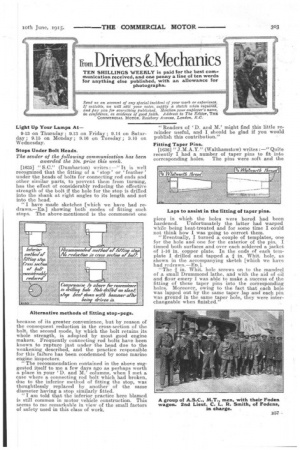rw. Drivers &Mechanics
Page 23

If you've noticed an error in this article please click here to report it so we can fix it.
TEN SHILLINGS WEEKLY is paid for the best communication received, and one penny a line of ten words for anything else published, with an allowance for photographs.
Light Up Your Lamps At —
943 on Thursday ; 9.13 on Friday ; 0.14 on Saturday; 9.15 on Monday; 0.16 on Tuesday ; 9.16 on Wednesday.
Stops Under Bolt Heads.
The sender of the following communication has been awarded the las. prize this week.
[1635] "5.0." (Dumbarton) writes —"It is well recognized that the fitting of a stop ' or 'feather ' under the heads of bolts for connecting rod ends and other similar parts, to prevent them from turning, has the effect of considerably reducing the effective strength of the bolt if the hole for the stop is drilled into the shank at right angles to its length and not into the head.
"I have made sketches [which we have had redrawn.—En.] showing both modes of fitting such stops. The above-mentioned is the commonest one
because of its greater convenience, but by reason of the consequent reduction in the cross-section of the. bolt, the second mode, by which the bolt retains .its whole strength, is adopted by most good engine makers. Frequently connecting rod bolts have been known to rupture just under the head due to the weakening described, and the practice responsible for this failure has been condemned by some marine engine inspectors,
"The recommendation contained in the above suggested itself to me a few days ago as perhaps worth a place in your 'D. and M.' columns, when I met a case where a. connecting rod bolt which had broken, due to the inferior method of fitting the stop, was thoughtlessly replaced by another of the same diameter having a stop similarly fitted. "I ara told that the inferior practice here blamed is still common in motor vehicle construction. This seems to me remarkable in view of the small factors of safety used in this class of work. "Readers of 'D. and M.' might find this little reminder useful, and I should be glad if you would publish this contribution/' Fitting Taper Pins.
[1636] " J.M.A.Y." (Walthamstow) writes.:—" Quite recently I had a number of taper pins to fit into corresponding holes. The pins were soft and the piece in which the holes were bored had been hardened. Unfortunately the latter had warped while being heat-treated and for some time I could not think how I was going to correct them.
"Eventually, I turned a couple of templates, one for the hole and one for the exterior of the pin. • I tinned both surfaces and over each soldered a jacket of 1-16 in. copper plate. In the ends of each tem plate I drilled and tapped a in. Whit. hole, as shown in the accompanying sketch [which we have had redrawn.—E.].
"The in. Whit. hole screws on to the mandrel of a small Drummond lathe, and with the aid of oil and flour emery I was able to make a success of the fitting of these taper pins •into the corresponding holes. Moreover, owing to the fact that each hole was lapped out by the same taper lap and each pin was ground in the same taper hole, they were interchangeable when finished."
























